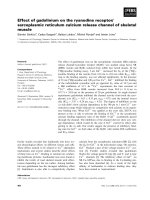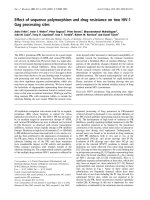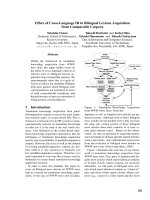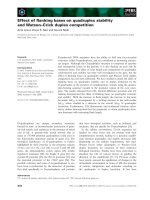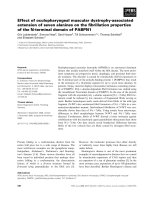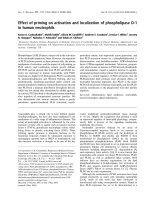Báo cáo khoa học: Effect of mutations at Glu160 and Val198 on the thermostability of lactate oxidase doc
Bạn đang xem bản rút gọn của tài liệu. Xem và tải ngay bản đầy đủ của tài liệu tại đây (440 KB, 6 trang )
Effect of mutations at Glu160 and Val198 on the thermostability
of lactate oxidase
Hirotaka Minagawa
1
, Jiro Shimada
1
and Hiroki Kaneko
2
1
Fundamental Research Laboratories, NEC Corp., Tsukuba, Japan;
2
Department of Applied Physics, College of Humanities and
Sciences, Nihon University, Tokyo, Japan
We have obtained two types of thermostable mutant lactate
oxidase – one that exhibited an E-to-G point mutation
at position 160 (E160G) through error-prone PCR-based
random mutagenesis, and another that exhibited an E-to-G
mutation at position 160 and a V-to-I mutation at position
198 (E160G/V198I) through DNA shuffling-based random
mutagenesis – both of which we have previously reported.
Our molecular modeling of lactate oxidase suggests that the
substitution of G for E at position 160 reduces the electro-
static repulsion between the negative charges of E160 and
E130 in the (b/a)
8
barrel structure, but a thermal-inactiva-
tion experiment on the five kinds of single-mutant lactate
oxidase at position 160 (E160A, E160Q, E160H, E160R, and
E160K) showed that the side-chain volume of the amino acid
at position 160 mainly contributes to the thermostability of
lactate oxidase. We also produced V198I single-mutant
lactate oxidase through site-directed mutagenesis, and ana-
lysed the thermostability of wild-type, V198I, E160G, and
E160G/V198I lactate oxidase enzymes. The half-life of
E160G/V198I lactate oxidase at 70 °C was about three times
longer
2
than that of E160G lactate oxidase, and was about 20
times longer
3
than that of wild-type lactate oxidase. In con-
trast, the thermostability of the V198I lactate oxidase was
almost identical to that of wild-type lactate oxidase. This
indicates that the V198I mutation alone does not affect
lactate oxidase thermostability, but does affect it when
combined with the E160G mutation.
Keywords: lactate oxidase; thermostability; site-directed
mutagenesis; random mutagenesis.
Lactate oxidase is widely used in biosensors to measure
the lactate concentration in blood [1], and increasing the
thermostability of lactate oxidase is a major factor in
prolonging the life of lactate oxidase-based lactate sensors.
One way to achieve this is to use naturally thermostable
enzymes isolated from thermophilic bacteria; however, it is
not always possible to obtain a desired enzyme (e.g. lactate
oxidase) from such bacteria. An alternative method is to
enhance protein stability through protein engineering [2],
and many researchers have investigated the relationships
between protein structure and thermostability [3,4], with
some proposing a mutation strategy based on knowledge of
the specific enzyme, such as ribonuclease H [5] or lysozyme
[6,7], to improve enzyme stability by means of rational
design. The thermostable thermolysin-like protease created
through rational design by van den Burg et al. [8], was one
of the most successful cases, but we still need to obtain a
naturally thermostable counterpart thermolysin and deter-
mine its 3D structure. The difficulty in trying to improve
enzyme stability through rational design is that this requires
solving the 3D structure of the enzyme, and, as the 3D
structure of the lactate oxidase has not yet been clarified, the
rational approach is therefore not applicable. An alternative
approach to increase the enzyme thermostability is to screen
mutants produced by random mutagenesis, such as error-
prone PCR or DNA shuffling [9–11], for thermostable
enzymes. The technique of DNA shuffling was introduced
by Stemmer [9], and has become a powerful tool for protein
engineering. We have already produced two types of
thermostable mutant lactate oxidase – E160G [12] and
E160G/V198I [13] – and have used E160G lactate oxidase to
develop a long-life lactate sensor [14]. However, while we
have shown that increasing the thermostability of lactate
oxidase prolongs the life of lactate sensors, the thermo-
stability of lactate oxidase must be further improved to
enhance the practicality of its application to lactate oxidase
sensors because the effect of enzyme stability tends to be
weaker when the enzyme is immobilized on a membrane
rather than in solution [14]. We have constructed a 3D
structure of lactate oxidase through homology modeling
[15]. In the case of E160G lactate oxidase, our model
suggests that the Glu residue at position 160 in wild-type
lactate oxidase is located in an a
3
helix, constituting part
of the (b/a)
8
barrel, and the mutation of Glu160 to Gly
stabilized the entire protein structure by eliminating the
negative charge repulsion between Glu160 and Glu130. To
confirm this hypothesis, five kinds of single-mutant lactate
oxidase (E160A, E160Q, E160R, E160K, and E160H) were
constructed by site-directed mutagenesis, and their thermo-
stability was compared with that of wild-type and E160G
mutant lactate oxidases. We also produced V198I single-
mutant lactate oxidase through site-directed mutagenesis,
and compared the thermostability and Michaelis constant
(K
m
) values of wild-type, V198I, E160G, and E160G/V198I
Correspondence to H. Minagawa, Fundamental Research Laborat-
ories, NEC Corp., Miyukigaoka 34, Tsukuba 305-8501, Japan.
Fax: + 81 29 856 6136, Tel.: + 81 29 850 2613,
E-mail:
Abbreviation: IPTG, isopropyl thio-b-
D
-galactoside.
(Received 7 April 2003, revised 30 June 2003, accepted 14 July 2003)
Eur. J. Biochem. 270, 3628–3633 (2003) Ó FEBS 2003 doi:10.1046/j.1432-1033.2003.03751.x
lactate oxidases to investigate the effect of an E160G/V198I
double mutation
4
on thermostability and enzyme activity.
Materials and methods
Construction of the mutant lactate oxidase gene
The five types of single-mutant lactate oxidase at position
160 (E160A, E160Q, E160H, E160R, and E160K) were
constructed by PCR-based site-directed mutagenesis using
the Quick Change Site-Directed Mutagenesis Kit (Strata-
gene). According to the kit protocol, the plasmid containing
the mutant lactate oxidase gene was amplified by PCR with
125 ng of each mutagenic primer (forward and reverse) and
50 ng of pLODwt [12], as a template, under the following
conditions: after heat denaturation at 95 °Cfor30s,we
applied 16 treatment cycles, each consisting of
30 s at 95 °C, 1 min at 55 °C, and 12 min at 68 °C. The
amplified plasmids were cooled on ice for 2 min and mixed
with DpnIat37°Cfor1h.Then1lL of plasmid was used
to transform Escherichia coli JM109 through electropora-
tion, and the electroporated JM109 cells were cultured
overnight at 37 °C on an L-plate (1% tryptone, 0.5% yeast
extract, 0.5% NaCl, 1.5% agar, and 100 lgÆmL
)1
ampicil-
lin). Several transformant plasmids were sequenced and the
plasmid which had the intentional mutation was selected as
mutant lactate oxidase. The E160G/V198I double-mutant
lactate oxidase was created by DNA shuffling [13], and the
V198I single-mutant lactate oxidase was created by site-
directed mutagenesis, as described above.
Lactate oxidase purification and activity measurements
The wild-type and all mutant lactate oxidases were purified
by the method previously reported [12]. E. coli JM109 cells,
harboring a plasmid containing lactate oxidase genes, were
grown overnight in L-broth (1% tryptone, 0.5% yeast
extract, 0.5% NaCl, and 100 lgÆmL
)1
ampicillin) at 37 °C.
Isopropyl thio-b-
D
-galactoside (IPTG) was then added to a
final concentration of 1 m
M
and the cells were cultured for a
further 2 h. The cells were then harvested and suspended in
a 50-m
M
potassium-phosphate buffer (pH 7.0) containing
1mgÆmL
)1
(w/v) lysozyme, and then stirred at room
temperature for 1 h. After ultrasonic disruption of the cells,
a crude extract was obtained by centrifugation. Phenyl-
methanesulfonyl fluoride and EDTA were added to the
supernatant as proteinase inhibitors, at final concentrations
of 1 m
M
.
5
After precipitation by ammonium sulfate (60/80%
saturation) at room temperature, the lactate oxidase was
purified by stepwise column chromatography using
Q-Sepharose FF, Phenyl Sepharose 6FF, and Superdex
pg200 (all from Pharmacia) in the FPLC system (Pharma-
cia). The purity was verified by SDS/PAGE, using PhastGel
and the PhastSystem (Pharmacia). Lactate oxidase activity
was determined by a peroxidase-coupled spectrophotomet-
ric method [12] using H
2
O
2
as the standard. Assays were
started by adding lactate oxidase to an activity assay
mixture containing 1.5 m
M
4-aminoantipyrine, 3.3 m
M
phenol, 100 m
ML
-lactate (lithium salt), 40 m
M
Hepes, and
6 U of horseradish peroxidase, in a final volume of 2 mL at
pH 7.3, and then the absorbance (A) at 500 nm was
monitored at room temperature. Protein concentrations
were measured with a bicinchoninic Protein Assay Regent
Kit (Pierce) using purified bovine serum albumin as the
standard. Irreversible enzyme inactivation was measured at
a protein concentration of 50 lgÆmL
)1
in a 40 m
M
Hepes
buffer, pH 7.3. Samples were incubated at 70 °Candthen
transferred to ice at different time-points during incubation.
Residual enzyme activity was then measured, as described
above. To determine the temperature dependence of the K
m
value for
L
-lactate at pH 7.3,
L
-lactate concentrations were
varied over a significant range (78 l
M
to 10 m
M
or 0.78 m
M
to 100 m
M
) and assays were conducted at 15, 25, 35, and
45 °C. K
m
values were calculated by plotting [S]/V vs. [S],
where [S] and V are, respectively, the
L
-lactate concentration
and the initial reaction rate.
Results and discussion
Irreversible enzyme inactivation assay of mutant
lactate oxidases at position 160
On the basis of our lactate oxidase model [15], position 160
is located in an a
3
helix constituting part of the (b/a)
8
barrel,
which is a common structure and the most basic frame in
the functionally important domain of a family of FMN-
dependent a-hydroxy acid oxidizing enzymes. The model
suggests that even the shortest distance between Glu160 and
Glu130 is 6.03 A
˚
and this distance is probably a result of the
electrostatic repulsion between the negative charges of these
twoglutamicacids.Wehaveexplainedthatthepartial
disorder is caused by this negative charge repulsion between
Glu160 and Glu130; the mutation of Glu160 to Gly
(E160G: which was made by error-prone PCR [12]) might
therefore stabilize the entire protein structure by eliminating
this charge repulsion [15]. To test this hypothesis, we
changed Glu160 to Gln (E160Q: the same side-chain volume
and no electric charge), His, Arg, and Lys (E160H, E160R,
E160K, respectively: positive electric charge). We also
created mutant Ala at position 160 (E160A), which has a
side-chain volume intermediate between those of Gln and
Gly. The thermal-inactivation curves of wild-type and
mutant lactate oxidase at position 160 (E160G, E160A,
E160Q, E160H, E160R, and E160K) at 70 °C are shown in
Fig. 1: the heat-inactivation curve of the wild-type lactate
oxidase exhibited a simple exponential decay, while those of
mutant lactate oxidases exhibited biphasic inactivation. This
suggests that at least two processes were involved in the
thermal inactivation of the mutants. Similar phenomena
have been previously observed for other thermostable
mutants (N212D and E160G/N212D) [12] and may be
explained by the multiple-exponential state in the unfolding
kinetics [16]. The relationships between biphasic inactivation
of the mutants and the enzyme thermostability are still not
fully understood and therefore further study is required.
The thermostabilities of E160H, E160R, and E160K were
almost the same as that of the wild-type lactate oxidase, and
the thermostabilities of E160Q and E160A were slightly
higher than that of the wild-type enzyme, but lower than
that of the E160G mutant. Substitution with a small,
nonelectric amino acid at position 160 seems to affect the
increase in lactate oxidase thermostability. In the a-helix,
Gly to Ala substitution was reported to stabilize the helix by
decreasing the entropy of the unfolding state [17]. In our
Ó FEBS 2003 Thermostability of mutant lactate oxidase
1
(Eur. J. Biochem. 270) 3629
case, E160G was more thermostable than E160A, thus the
amino acid substitution at position 160 might have affected
the a
3
helix flexibility through interaction with other
residues, such as Glu130 or Arg203. It is difficult to explain
the thermostability mechanisms of the E160G mutation on
the basis of this model structure, and the precise molecular
structure of lactate oxidase would have to be known to do
so. Our group and other researchers [
6
18] have attempted to
determine the 3D structure of lactate oxidase, and prelimi-
nary results were obtained; however, the complete detailed
structure of lactate oxidase has not yet been determined.
Irreversible enzyme-inactivation assay of mutant
lactate oxidases at positions 160 and 198
We created V198I single-mutant lactate oxidase by site-
directed mutagenesis using a Quick Change Site-Directed
Mutagenesis Kit (Stratagene) and purified the lactate
oxidase, as described above. Thereafter, we compared the
irreversible thermostability and the temperature dependence
of the K
m
value with the wild-type, E160G, and E160G/
V198I lactate oxidase. The thermal-inactivation curve of the
E160G/V198I mutant at 70 °C was obviously less steep
than that of the E160G mutant; however, there was very
little difference in the thermal-inactivation curves of the
V198I mutant and wild-type lactate oxidases (Fig. 2). This
indicates that the V198I mutation affects the thermostability
of the E160G mutant lactate oxidase, but has a minimal
effect on the thermostability of the wild-type enzyme. The
temperature dependence of the wild-type, E160G, V198I,
and E160G/V198I K
m
values for
L
-lactate are shown in
Fig. 3. The temperature dependence of the K
m
values of
Fig. 1. Thermal inactivation of wild-type and mutant lactate oxidases at
position 160. Residual activities of wild-type (d), E160G (h), E160A
(n), E160Q (s), E160H (e), E160R (,), and E160K (
) lactate
oxidases are shown, expressed as a percentage of the original activity.
Enzymes in 40 m
M
Hepes buffer (pH 7.3) were incubated at 70 °Cfor
different periods of time. Results represent the mean value of experi-
ments performed in triplicate ± SD.
Fig. 2. Thermal inactivation of wild-type, E160G, V198I, and E160G/
V198I lactate oxidases. Residual activities of wild-type (d), E160G
(h), V198I (s), and E160G/V198I (e) lactate oxidases are shown,
expressed as a percentage of the original activity. The enzymes, in
40-m
M
Hepes buffer (pH 7.3), were incubated at 70 °C for different
periods of time. Results represent the mean value of experiments
performed in triplicate ± SD.
Fig. 3. Temperature dependence of the Michaelis constant (K
m
) values
of wild-type, E160G, V198I and E160G/V198I lactate oxidases. The K
m
values of wild-type (d), E160G (h), V198I (s), and E160G/V198I (e)
lactate oxidases, at 15, 25, 35, and 45 °C, are shown. The concentration
of
L
-lactate varied from 78 l
M
to 10 m
M
(wild-type and V198I) or
0.78 m
M
to 100 m
M
(E160G and E160G/V198I), and assays were
conducted in 40 m
M
Hepes buffer at pH 7.3.
3630 H. Minagawa et al. (Eur. J. Biochem. 270) Ó FEBS 2003
E160G and E160G/V198I were almost identical, and the
K
m
values of these two mutants were higher than that of
the wild-type lactate oxidase at a temperature range of
15–45 °C; thus, the K
m
value and the temperature depend-
enceofthewild-typelactateoxidasewerealmostthesameas
for the V198I mutant lactate oxidase. In terms of the K
m
value, the E160G mutation greatly affected the lactate
oxidase activity, but the V198I mutation had no or only a
minor effect on the catalytic activity of lactate oxidase with
respect to the wild-type and E160G lactate oxidases. The
Fig. 4. Stereoview of the model structure of lactate oxidase: a side view of the (b/a)
8
barrel. The side-chains of Val198, Glu160, Arg203, Glu130, a
pyruvate molecule and an FMN molecule are shown as a stick model. The labels of the mutation sites, Glu160 and Val198 are colored green. All the
atoms of Gly126, Ala127 and Thr128 are displayed by a van der Waals surface (CPK) model. The atom-type colors are as follows: carbon (green),
oxygen (red), nitrogen (blue) and phosphate (magenta). The region considered a flexible large loop structure (residues 189–215), on the basis of the
structural comparison between glycolate oxidase and flavocytochrome b
2
, is shown as a blue ribbon (see also the thick lines in Fig. 5). Red cylinders
and yellow arrows represent a-helixes and b-strands, respectively, with the a
2
, a
3
, a
D
and a
E
helices denoted by a2, a3, aD and aE, respectively. The
secondary-structure nomenclature is according to Lindqvist [19]. The picture was created using
INSIGHT II
software (Version 4.3, Accelrys Inc.) on an
ONYX2 workstation (Silicon Graphics, Inc.).
Fig. 5. Variation of the atomic temperature factors averaged for the main-chain atoms of spinach glycolate oxidase [19]. Thedatawereobtainedfrom
the Protein Data Bank (entry ID: 1GOX). The average B-factor of each residue is plotted against the residue number. Residues 172–204, in which
even the main-chain structures are not superimposed between glycolate oxidase and the FMN-binding domain of flavocytochrome b
2
,are
emphasized by thick lines. Residues 189–197, which are disordered in the crystal, are shown as dotted lines. Only the a
D
helix, a
E
helix and the
secondary structures included in the (b/a)
8
barrel are indicated. The left arrow indicates the value for Arg143 (corresponding to Glu160 of lactate
oxidase), and the right arrow indicates the value for Lys181 (corresponding to Val198 of lactate oxidase).
Ó FEBS 2003 Thermostability of mutant lactate oxidase
1
(Eur. J. Biochem. 270) 3631
specific activity of V198I lactate oxidase was approximately
the same as that of wild-type lactate oxidase, and that of
E160G/V198I mutant lactate oxidase was approximately
the same as that of E160G (data not shown). These
observations suggest that the V198I mutation only affects
the thermostability of the enzyme when it combines with
the E160G mutation.
Why does the single E160G mutation affect the thermo-
stability whereas the V198I mutation does not? According
to our lactate oxidase model [15], position 160 is located in
an a
3
helix constituting part of the (b/a)
8
barrel (Fig. 4),
which is a common structure and the most basic frame in
the functionally important domain of a family of FMN-
dependent a-hydroxy acid oxidizing enzymes. The atomic
temperature factors of the corresponding position
(B-value ¼ 25 A
˚
2
) in glycolate oxidase suggest that posi-
tion 160 is not flexible, whereas the average isotropic
B-value for all the main-chain protein atoms is 26.5 A
˚
2
(Fig. 5) [19]. Position 198, on the other hand, is located in a
large loop (residues 189–215)
7
(Fig. 4). Here, we defined this
loop as the region corresponding to the place where the
main-chain structures of two homologous enzymes –
glycolate oxidase [19] and the FMN-binding domain of
flavocytochrome b
2
[20] – are not superimposed on the basis
of the 3D structural fitting. The loop starts just after the end
of the a
D
helix and terminates halfway along the a
E
helix,
thus it is quite far from the core structure [i.e. the (b/a)
8
barrel]. Moreover, the atomic temperature factors of the
corresponding position in glycolate oxidase (Fig. 5) suggest
that the loop which includes position 198 is very flexible.
We infer from this that position 160 contributes more
directly to stabilizing the (b/a)
8
barrel structure than does
position 198. Therefore, the mutation at position 160
should have a much greater effect on stability than the
mutation at position 198.
Why does the V198I mutation further increase the
thermostability of the E160G mutant? Glu160 in the wild-
type lactate oxidase corresponds to Arg143 in the a
3
helix of
glycolate oxidase. From detailed observation of the glyco-
late oxidase crystal structure [19], we have learned that
Arg143 plays a very important role in maintaining the
stability of the enzyme molecule [15]. The residue stabilizes
theentire(b/a)
8
barrel structure by forming a strong salt
bridge with the Glu114 in the a
2
helix. It also reinforces the
interaction between the (b/a)
8
barrel structure and the large
loop, mentioned above (residues 172–204 in glycolate
oxidase and residues 189–215 in the wild-type lactate
oxidase), by forming a hydrogen-bond network between
the NH
2
of Arg143 and the main-chain carbonyls of Lys181
and Asn182 directly, and the main-chain carbonyl of
Glu184 by way of a water molecule. However, in lactate
oxidase, the exchange of the E160G mutation appears to
completely eliminate the interaction between the (b/a)
8
barrel structure and the large loop that would otherwise
occur through the hydrogen bond network between Glu160
in the barrel and Arg203 in the loop, in return for stabilizing
the barrel structure (see Fig. 4). A Val fi Ile mutation at
position 198 in the large loop may restore the interaction.
Actually, according to our lactate oxidase model (Fig. 4),
the extension of the side-chain generated by the Val fi Ile
mutation forms van der Waals contacts with the side-chain
atoms of Thr128 or the main-chain atoms of Gly126 and
Ala127. As residues 126–128 are located just before the a
2
helix, it is probable that the Val fi Ile mutation at position
198 reinforces the interaction between the (b/a)
8
barrel
structure and the large loop via van der Waals forces
between the Ile side-chain and the side-chains of amino
acids near the a
2
helix.
The additive effects of mutations on enzyme stability
have often been reported [21]. Hence, one strategy to
improve enzyme stability is to screen several thermostabi-
lized mutant enzymes that have a single amino acid
mutation, and then to generate a combined mutant that
has two or more amino acid mutations. We have previously
applied this Ôadditive strategyÕ to improve the thermostabi-
lity of lactate oxidase [12]. In that work we obtained two
types of thermostable mutant lactate oxidase (N212D and
E160G) through random mutagenesis and constructed a
double mutant N212D/E160G lactate oxidase. The thermo-
stability of that double mutant, however, was approxi-
mately the same as that of E160G lactate oxidase [12]. In
this case, we found that the N212D mutation affects the
enzyme stability of wild-type lactate oxidase, but not that of
E160G lactate oxidase. Although many researchers have
found that combinations of mutations, and the resulting
effects of the amino acid substitutions at different positions,
are usually additive, our findings for two types of double
mutations (N212D/E160G and E160G/V198I) indicate that
the cooperative amino acid substitutions also have an
important effect on enzyme thermostability.
Acknowledgements
We thank M. Kitabayashi of NEC’s Fundamental Research Labor-
atories for her technical assistance in the sample preparation.
References
1. Ito, N., Matsumoto, T., Fujiwara, H., Matsumoto, Y., Kayashima,
S., Arai, T., Kikuchi, M. & Karube, I. (1995) Transcutaneous
lactate monitoring based on a micro-planar amperometric bio-
sensor. Anal. Chim. Acta 312, 323–328.
2. Bishop, B., Koay, C.D., Sartorelli, C.A. & Regan, L. (2001)
Reengineering granulocyte colony-stimulating factor for enhanced
stability. J. Biol. Chem. 276, 33465–33470.
3. Fa
´
ga
´
in, C.O
´
. (1995) Understanding and increasing protein sta-
bility. Biochim. Biophys. Acta 1252, 1–14.
4. Lee, B. & Vasmatzis, G. (1997) Stabilization of protein structures.
Curr. Opin. Biotechnol. 4, 423–428.
5. Ota, M., Kanaya, S. & Nishikawa, K. (1995) Desk-top analysis of
the structural stability of various point mutations introduced into
ribonuclease H. J. Mol. Biol. 248, 733–738.
6. Imoto, T. (1996) Engineering of lysozyme. EXS 75, 163–181.
7. Takano, K., Ota, M., Ogasahara, K., Yamagata, Y.,
Nishikawa, K. & Yutani, K. (1999) Experimental verification of
the Ôstability profile of mutant proteinÕ (SPMP) data using mutant
human lysozymes. Protein Eng. 12, 663–672.
8. Van den Burg, B., Vriend, G., Veltman, O.R., Venema, G.,
Eijsink, V.G. (1998) Engineering an enzyme to resist boiling. Proc.
NatlAcad.Sci.USA95, 2056–2060.
9. Stemmer, W.P. (1994) Rapid evolution of a protein in vitro by
DNA shuffling. Nature 370, 389–391.
10. Moore, J.C., Jin, H.M., Kuchner, O. & Arnold, F.H. (1997)
Strategies for the in vitro evolution of protein function: enzyme
evolution by random recombination of improved sequences.
J. Mol. Biol. 272, 336–347.
3632 H. Minagawa et al. (Eur. J. Biochem. 270) Ó FEBS 2003
11. Giver,L.,Gershenson,A.,Freskgard,P.O.&Arnold,F.H.(1998)
Direct evolution of a thermostable esterase. Proc. Natl Acad. Sci.
USA 95, 12809–12813.
12. Minagawa, H., Nakayama, N., Nakamoto, S. & Kaneko, H.
(1998) Lactate oxidase thermostabilized by random mutagenesis.
Res. Commun. Biochem. Cell Mol. Biol. 2, 149–156.
13. Minagawa, H. & Kaneko, H. (2000) Effect of double mutation on
thermostability of lactate oxidase. Biotechnol. Lett. 22, 1131–1133.
14. Minagawa, H., Nakayama, N., Matsumoto, T. & Ito, N. (1998)
Development of long life lactate sensor using thermostable mutant
lactate oxidase. Biosens. Bioelectron. 13, 313–318.
15. Kaneko, H., Minagawa, H., Nakayama, N., Nakamoto, S.,
Handa, S., Shimada, J., Takada, T. & Umeyama, H. (1998)
Modeling study of a lactate oxidase–ligand complex: substrate
specificity and thermostability. Res. Commun. Biochem. Cell Mol.
Biol. 2, 234–244.
16. Chan, S.H. & Dill, A.K. (1998) Protein folding in the landscape
perspective: Chevron plots and non-arrhenius kinetics. Proteins
30, 2–33.
17. Matthews, B.W., Nicholson, H. & Bechtel, W.J. (1987) Enhanced
protein thermostability from site-directed mutations that decrease
the entropy of unfolding. Proc. Natl Acad. Sci. USA 84, 6663–
6667.
18. Morimoto, Y., Yorita, K., Aki, K., Misaki, H. & Massey, V.
(1998)
L
-lactate oxidases from Aerococcus viridans crystallized as
an octamer. Preliminary X-ray studies. Biochimie 80, 309–312.
19. Lindqvist, Y. (1989) Refined structure of spinach glycolate oxidase
at 2 A
˚
resolution. J. Mol. Biol. 209, 151–166.
20. Xia, Z.X. & Mathews, F.S. (1990) Molecular structure of flavo-
cytochrome b2 at 2.4 A
˚
resolution. J. Mol. Biol. 212, 837–863.
21. Wells, J.A. (1990) Additivity of mutational effects in proteins.
Biochemistry 29, 8509–8517.
Ó FEBS 2003 Thermostability of mutant lactate oxidase
1
(Eur. J. Biochem. 270) 3633



